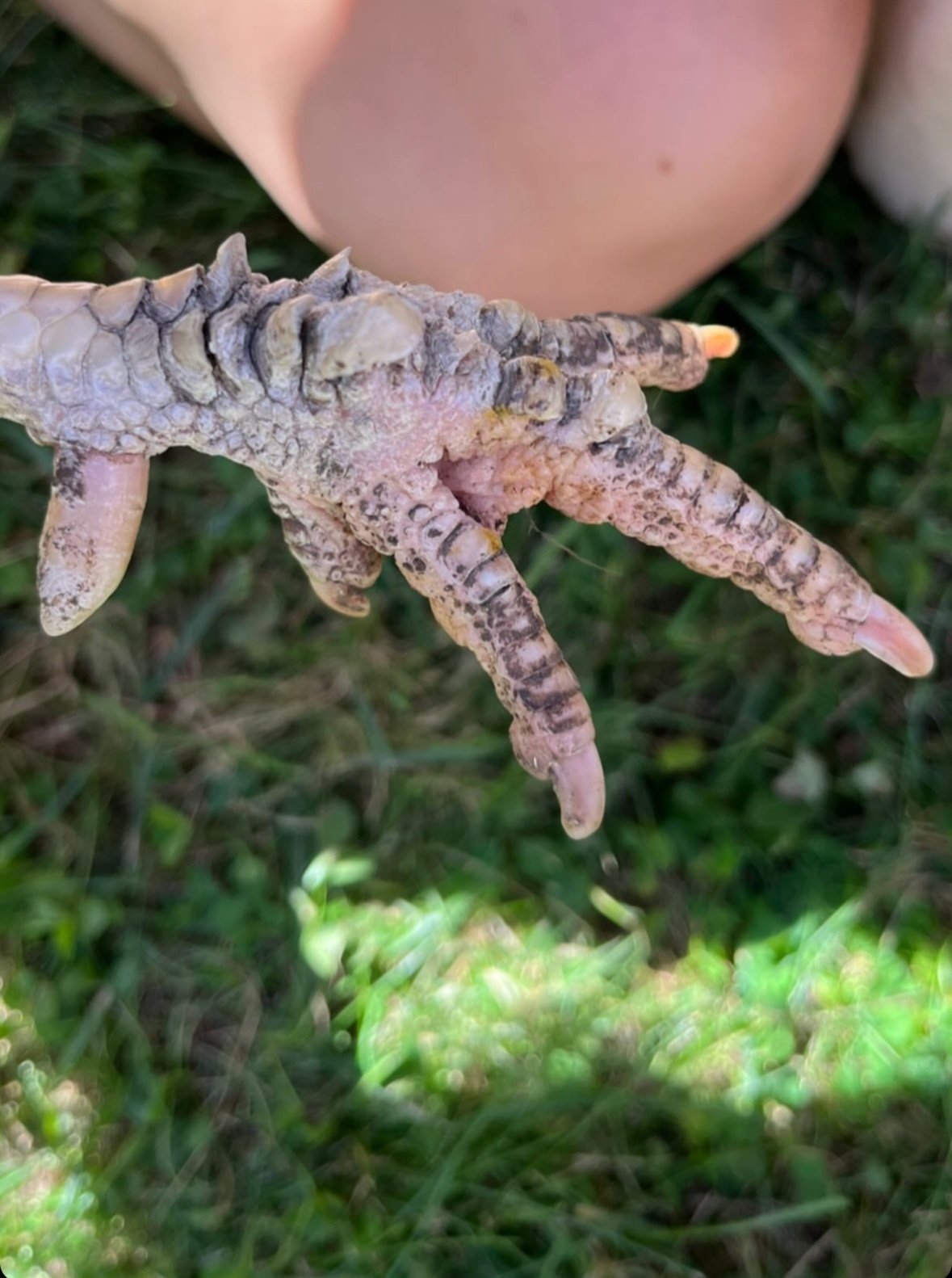External parasites are a common occurrence in chickens. It is nothing to be alarmed about. Chickens live outside and we don’t give them a monthly flea treatment like our dogs and cats so they can contract parasites fairly easily. As a responsible poultry keeper, it is our job to complete monthly checks and treat the problem when it occurs. Chicken who are left with mites and lice will have severe health issues and it can cause death. Chickens will commonly come down with northern fowl mites, red poultry mites, poultry lice, scaly leg mites, or depluming mites.
To watch my youtube video about mites/lice and see actual mites crawling, CLICK HERE!
Mites and Lice
Signs include:
-Dirty vent feathers
-Red skin or scabs around the vent
-Missing feathers (typically above tail and around the vent)
-Chickens who are lethargic, listless, depressed
-Excess preening and scratching
-Avoiding the roosts at night
-Egg laying stops
-Mite eggs around the base of the feathers and on the shafts (looks like dust/dander)
-Lice eggs on the base of the feathers (looks like tiny grains of rice)
-Mites on eggs, crawling on your skin, on the chicken
The Treatment:
My preferred treatment for lice and mites is Elector PSP. While it is more expensive than other treatment options, it is safer, more effective, nontoxic, and safe for you and the chickens. There is no egg withdraw time so you can eat the eggs while the chickens are being treated. The great part is you only have to treat them once. It doesn’t expire and you only use a little bit of the bottle. Save it in a dry location out of the sun and freezing temperatures and shake it well before each use. Mix the solution according to the information included with the bottle (I do about 9ml per gallon of water). You can make a small batch and add it to a spray bottle and spray the chickens on as much of their skin as you can focusing on the vent, neck and under the wings. If you have a lot of chickens, you might want to mix it in a 5 gallon bucket and swish the chickens around gently to coat the skin. Avoid their face and ears. Do not wet chickens when the outside temperature is cold. Clean all bedding from the coop, mix the solution in a large weed killer spray container and spray down the coop well. Allow it to fully dry before adding more bedding. I usually wait 24 hours and let the solution do it’s job before adding bedding. Burn or dispose of infested bedding. PS: Elector PSP is ok to use in organic farming as it is a natural substance.
Other options…
Ivermectin: This is a good option when it is winter and you can’t get the chickens wet or if they also have roundworms because it will treat both. You can find dosage and other information here. The trouble with ivermectin is that you can overdose the chickens and cause harm and it isn’t as safe. There is an egg withdraw time of 7 days after each treatment and you have to treat at least twice 10-14 days apart.
Permectrin II: I don’t have any experience with this because it is toxic and I avoid using it. You do have to do a repeat treatment and it has a long list of precautions and suggestions of when to call poison control. While it is cheaper per ounce, you use more ounces to make the solution and the dangers aren’t worth it for me. You can read more about it here.
Dusting Powders: There are so many dusting powders on the market but they aren’t as effective as the other treatments. They take multiple applications to work and breathing them in is dangerous.
Mite eggs on the feathers look like dust/dandruff
Mites on a tan egg. They are very small!
Lice eggs on the feather shafts are more compacted and look like tiny grains of rice. Images sent from a few followers!
Scaly Leg Mites
Signs include:
-Flakey looking leg scales that don’t lay flat (this can be minor or pretty severe)
-Crusting on the legs
-Scales that fall off
-Thickness forming on the legs
Treatment:
Soak the legs in warm epsom salt water (1/2 cup per 3 gallons) for 15 minutes to loosen the scales and dead skin. Give them a quick scrub and dry with paper towels. Dip the legs in olive oil and rub it in. Slather the legs in 2 TBS of petroleum jelly mixed with 5 drops of tea tree oil. Repeat the last step daily for a week.
These images are from a follower. They rescued chickens who were kept on gravel and neglected. They had severe scaly leg mites along with many other issues.
Depluming Mites
These are mites that can’t be seen. They burrow under the skin.
Signs include:
-Missing feathers that can’t be explained
-Feathers that break easily
-Excessive preening
Treatment:
Unfortunately, these ones are hard to treat because most powders don’t penetrate into the skin. We have not had to deal with depluming mites yet so I can only direct you to other sources. Here are some links to check out…
https://poultrydvm.com/condition/depluming-itch
https://tvmdl.tamu.edu/2020/10/05/depluming-mites-in-birds/#:~:text=These%20mites%20are%20very%20small,(not%20licensed%20for%20chickens).
The images below are from a follower who had to deal with depluming mites. Notice how there aren’t pin feathers coming in so it is not molting.
Prevention of all Parasites
You can’t avoid external parasites but you can lesson your chances by doing a few easy things.
-Keep the coop and run clean.
-Prevent wild birds and rodents from entering the chicken space by using hardware cloth.
-Pick up feathers and fallen leaves.
-Provide areas to dust bathe all year long.
-Sprinkle First Saturday Lime in the coop and run monthly. (You can find it here and use my code purelychickens)







